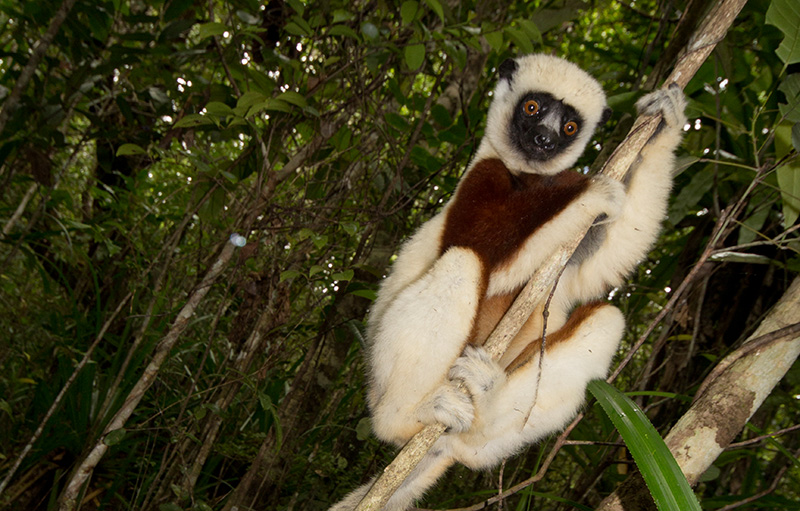With their typical teddy bear-like appearance, they wrap many travellers around their fingers: Coquerel’s Sifakas (Propithecus coquereli) wear a plush, snow-white fur, whereby the upper sides of the arms and thighs as well as the chest are deeply chocolate brown colored. With up to a half meter head-torso-length – in addition, another half meter tail – as well as approximately 4 kg of body weight, they belong altogether to the smaller sifakas. Their home is the northwest of Madagascar, more precisely the dry forests between the large river Betsiboka and the somewhat smaller Maevarano.

The beautiful Sifakas were first described in 1867 by the famous French explorer Alfred Grandidier, who had travelled to Madagascar several times and discovered many plant and animal species there. He named the lemurs after the priest, military doctor and insect researcher Charles Coquerel, whom Grandidier highly appreciated. In the same year Coquerel died of a tropical disease on La Réunion.
However, the sifakas named after him still exist today, and they leap and climb among the trees just like they did then very skilfully. The lemurs usually live in family groups of three to ten animals, but there are also mixed groups. If related Coquerel’s Sifakas meet again after a long time, they rub their noses together to greet each other. Each group has a territory of 0.04 to 0.09 km², which are marked by scent glands. If necessary, the borders are very aggressively defended against other lemur groups, even if they belong to a different species.
Leaders of a Coquerel’s group are always females, and even the lowest ranking female still stands above the highest male in the hierarchy of the Sifakas. The ladies drive away males from preferred feeding and sleeping places, and the latter appease the females with a rolled tail between their legs and quiet chattering noises with bleached teeth. Even the mating in January and February, i.e. at the end of the rainy season, is determined by the females: they choose their partners according to their very own criteria, and whoever has won a competitive battle with the males is therefore far from being allowed to mate with the beloved. Each female usually mates with several selected males. It is therefore difficult to determine who the young are from – often children of foreign Coquerel’s Sifaka groups who only passed by for a short time.

After approximately five and a half months, the females give birth to their young in the dry season, in June or July. Each female gives birth to only one baby, which she takes care of with dedication. During the first month, the little one clings to her mother’s belly, but after only four weeks he or she dares to get on her back and explores the surroundings on first excursions. The young Coquerel’s Sifakas are weaned for only five or six months, then they have to look for their own food. The pretty teddy lemurs are already grown up at the age of one year, but they only become sexually mature at the age of three to four.
Coquerel’s Sifakas spend most of foraging. They feed purely vegetarian, and they have to spend a corresponding amount of time grazing suitable plants. They cover almost one kilometre a day between the treetops in this way. The menu changes with the rainy and dry seasons on the red island from flowers, buds and fruits to leaves and dry bark.
Today, according to the IUCN, the Coquerel’s Sifakas are threatened with extinction, even if an estimated 47,000 individuals still live in Ankarafantsika National Park alone. The northwest of Madagascar is their only habitat worldwide and is fragmented into many small fragments of forest between which the lemurs can hardly change. The genetic exchange of the entire population is thus severely restricted. Moreover, only a very small proportion of the remaining dry forests are protected, so that the habitat of the Coquerel’s Sifakas, which has already declined sharply, is dwindling. The widespread deforestation for coal and farmland is taking its toll inexorably.

However, there is a small ray of hope: Unlike many other lemurs, Coquerel’s Sifakas are less choosy about their diet. They can also feed on the leaves, buds and fruits of tree species not originally native to Madagascar and are not very shy, but are all the more curious, so that they can reach the outskirts of villages in many places. Secondary vegetation is well used by them, and even in mangroves Coquerel’s Sifakas could already be observed. Coquerel’sSifakas are also among the most researched lemurs in Madagascar, as they are kept, propagated and studied in a few zoos worldwide. The Duke Lemur Center in Durham, England, from which all other Coquerel’s in other zoos in the USA are descended, is in charge. In recent years, much research has been done into the eating habits, social behaviour and communication of the Coquerel’s Sifakas. Among the publications to date is even a treatise which states that most adult Coquerel’s males and individual females are left-handed – at least in captivity. What it looks like in the wilderness of Madagascar remains to be explored.
 MADAMAGAZINE Your Magazine about Madagascar
MADAMAGAZINE Your Magazine about Madagascar












